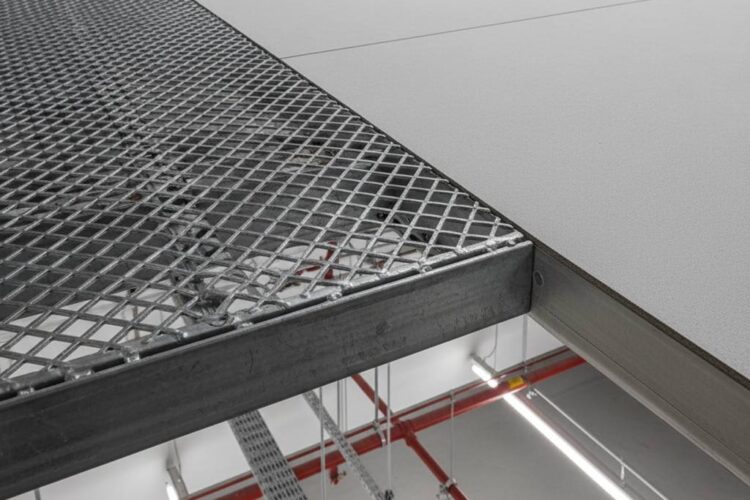
Flooring & Ceiling Considerations in Mezzanine Construction
When designing a mezzanine, much of the attention often goes to stairways, handrails, and storage layouts. However, two equally critical elements—the flooring and the ceiling—play a major role in the functionality, safety, and overall experience of a mezzanine space. Whether it’s for a warehouse, office, retail, or industrial setting, getting these details right can make all the difference.
Choosing the Right Mezzanine Flooring
The flooring of a mezzanine must balance load-bearing capacity, durability, and usability depending on its purpose.
- Steel Grating – Ideal for warehouses and industrial mezzanines where airflow, sprinkler coverage, and slip resistance are essential.
- Timber Decking – A cost-effective option, commonly used in office or light storage mezzanines. It’s easy to install and provides a smooth finish.
- Concrete Topping – Offers maximum strength and fire resistance, making it suitable for heavy machinery or high-traffic areas.
- Composite Panels – A modern choice for retail or office spaces, offering both strength and an aesthetic finish.
The flooring decision impacts not only safety but also how comfortably the mezzanine can be used day to day.
Fire Protection Under the Floor
The underside of mezzanine flooring doubles as the ceiling of the lower level. This area must be carefully designed to meet fire safety standards.
- Fire-rated boards or suspended ceilings can be installed below the mezzanine deck.
- Integrating sprinkler systems ensures compliance with building regulations.
- Finishing choices for the ceiling also affect acoustics and lighting.
This ensures that mezzanines remain safe while blending seamlessly with the rest of the building.
Enhancing the Ceiling for Usability
A mezzanine’s ceiling isn’t just about safety—it also impacts comfort and aesthetics.
- Lighting: Recessed or LED strip lighting can transform the lower level into a functional, inviting workspace.
- Acoustic Panels: Useful in office or retail mezzanines to reduce noise transfer between levels.
- Suspended Ceilings: Create a clean, professional look while hiding utilities such as wiring and ducts.
Load Distribution & Structural Safety
The flooring must be engineered to distribute loads evenly across the mezzanine structure. This includes:
- Pallet loads in warehouses
- Heavy foot traffic in retail spaces
- Office furniture and partition walls
Engineers factor in both static loads (stored goods, fixtures) and dynamic loads (movement of people and equipment) to ensure the mezzanine is safe and reliable.
Designing for Flexibility
Businesses grow and change—your mezzanine should too. Flooring systems can be modular, allowing future adjustments for new partitions, cabins, or changes in use. Similarly, ceilings can be adapted to house new lighting, ventilation, or IT cabling without major reconstruction.
Conclusion
Flooring and ceiling choices are often overlooked in mezzanine projects, but they directly impact safety, compliance, and comfort. From the load-bearing strength of the floor to the fire protection and finish of the ceiling, these elements shape both functionality and aesthetics.
A well-designed mezzanine floor and ceiling not only support operations but also future-proof your business space. Ready to design a mezzanine that balances strength, safety, and style? Contact our team today to get started.



